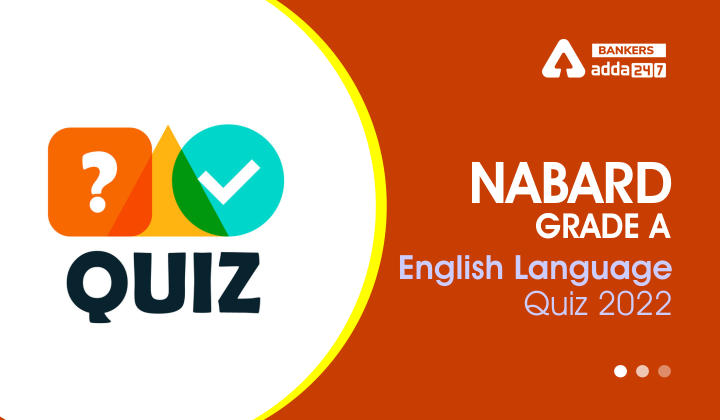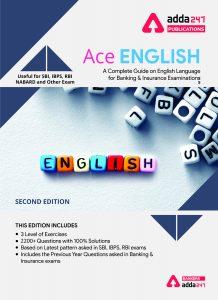Directions (1-10): Read the passage carefully and answer the questions given below it. Certain words/ phrases have been given in bold to help you locate them while answering some of the questions.
The rapid development of food technology and food-processing industries has raised the risk of contamination by additives. Ironically enough, the Green Revolution has spawned other sources of food contamination, through pesticides and agro-chemicals. Moreover, unscrupulous traders adulterate food to increase the margin of profit. Freshwater fish contains mercury from industrial effluents; poultry chicken and eggs are contaminated with hormones that can lead to prostate cancer.
Every bite of food is contaminated with pesticides. Indeed, we eat at our peril. Natural poisons can have a chronic pharmacological effect. However, many of these toxic elements can act as a protection against animals feeding on them. At least 5,000 species of marine fish are known to be contaminated. Moreover, there are natural contaminants of food as for example bacteria, fungi and other toxins. The use of antibiotics in farms has contributed to the emergence and spread of resistant bacteria. Regular exposure to sub-therapeutic doses of antibiotics promotes the development of resistant bacteria in the gut. The resistant bacteria can be transmuted to those who eat chicken through the phenomenon known as “horizontal transfer”. Around 75 per cent of antibiotics used are not absorbed by animals and excreted in their wastes, posing a serious risk to public health. Both resistant bacteria and antibiotic residues also enter the food-chain through the soil and water. Even vegetarians can be affected from farm bacteria that is transferred to those who do not eat chicken or are vegetarians.
Food safety is also threatened by numerous contaminants that emanate from industrial pollution. The Deadly Trio – mercury (Hg), cadmium (Cd and lead (Pb) and the polychlorinated biphenyls (PCBs) have been potential hazards. Food toxicity is caused by industrial pollutants. Lead is also a cumulative poison and once it is absorbed, it tends to accumulate in the body. Food additives – preservatives, colouring agents, flavour enhancers, sweetening agents, emulsifiers, antioxidants etc – are now integral to processed food. These exogenous substances, of both natural and artificial origin, are intentionally added to make food attractive to consumers by enhancing both organoleptic (sensory) and non-organoleptic (non-sensory) characteristics. Processed food is not wholesome and ought not to be consumed by children; experts have now established a link between processed food and childhood hyperactivity. Junk food contains little or no protein, vitamins or minerals but is rich in salt, fat and energy. There is need to regulate junk food as robust evidence links such consumption to non-communicable diseases (NCD) such as diabetes, hypertension and heart diseases. Childhood obesity is no less a matter of serious concern.
Adulterated food can lead to dropsy, infertility, lathryrism, glaucoma, brain, liver and kidney damage, cancer, skin diseases, cardiac ailment and even death. Food can hardly be ‘pure’ if we adhere to the meaning of the term as mentioned in the dictionary. But it can be ‘safe’. However, to meet the growing menace of toxicological hazards of food, a multi-dimensional approach is essential by strengthening the activities of regulating agencies, along with empowering the enforcement authorities and also by alerting consumers to be conscious of what they are eating and how much. Consumers should not be alarmed unnecessarily. Sound scientific analysis and dissemination of the right information should be the foundation of food safety regulation.
Q1. Choose the word which is most similar in meaning to the word ‘Peril’ as used in the passage.
(a) Safety
(b) Security
(c) Risk
(d) Faith
(e) Satisfaction
Q2. Which of the following is not the cause of adulterated food?
(a) Lathyrism
(b) Cardiac ailment
(c) Dropsy
(d) Obesity
(e) Glaucoma
Q3. How can the toxicological hazards of food be curbed?
i) By giving power to the enforcement authorities.
ii) By issuing guidelines to food production companies.
iii) By strengthening the activities of the regulating agencies.
(a)Both (ii) and (iii).
(b) Only (ii).
(c) Both (i) and (ii).
(d) Both (i) and (iii).
(e) All of these.
Q4. Which of the following is not true about the junk food?
(a) Junk foods lead to non communicable diseases such as diabetes, hypertension and heart disease.
(b) Junk foods contain no protein, vitamins or minerals.
(c) Junk foods are rich in salt and energy.
(d) It leads to childhood obesity.
(e) None of these
Q5. Which of the following is a cumulative poison?
(a) Mercury
(b) Cadmium
(c) Lead
(d) PCB
(e) All of the above
Q6. Choose the word which is MOST OPPOSITE in meaning of the word ’emanate’ as used in the passage?
(a) Arise
(b) Radiate
(c) Emerge
(d) Simplified
(e) Hold
Q7. Choose the word which is MOST SIMILAR in meaning to the word ‘exogenous’ as used in the passage?
(a) Endogenous
(b) Internal
(c) Intrinsic
(d) External
(e) Endogenic
Q8. Which of the following is not true according to the passage?
(a) Around 75 per cent of antitoxin is not consumed by the animals.
(b) Both (d) and (e)
(c) Antagonistic bacteria and antibodies can introduce food chain through soil and water.
(d) The resistant bacteria cannot be transmitted.
(e) Vegetarians cannot be affected by farm bacteria.
Q9. Choose the word which is MOST OPPOSITE in meaning of the word ‘Spawned’ as used in the passage?
(a) Destroyed
(b) Hatched
(c) Created
(d) Generated
(e) Issued
Q10. Which of the following is/are not food additives?
(a) Oxidants
(b) Emulsifiers
(c) Preservatives
(d) Anti-oxidants
(e) Flavour enhancers
Directions (11-15): Rearrange the following six sentences (A), (B), (C), (D), (E) and (F) in the proper sequence to form a meaningful paragraph and then answer the questions given below.
(A) They pay the “listed” price for items; perhaps they avoid conflict.
(B) Yet many individuals do not think of themselves as bargainers.
(C) But a shopping in local market gives you an opportunity to bargain and reflect about what you do as negotiator.
(D) Many people bargains and negotiates.
(E) Their reluctance to bargain may reflect reserve nature or lack of experience to risk through negotiation.
(F) Some people enjoy it; some people are good at it.
Q11. Which of the following would be the LAST sentence after rearrangement?
(a) E
(b) C
(c) A
(d) B
(e) F
Q12. Which of the following would be the FIRST sentence after rearrangement?
(a) D
(b) B
(c) F
(d) A
(e) C
Q13. Which of the following would be the THIRD sentence after rearrangement?
(a) F
(b) D
(c) B
(d) A
(e) E
Q14. Which of the following would be the FIFTH sentence after rearrangement?
(a) B
(b) E
(c) F
(d) A
(e) C
Q15. Which of the following would be the SECOND sentence after rearrangement?
(a) D
(b) A
(c) B
(d) C
(e) F
Solutions
S1. Ans. (c)
Sol. Peril means serious and immediate danger. So, Risk is the word which is similar in meaning to it.
S2. Ans. 4
Sol. Obesity
S3. Ans. (d)
Sol. Refer to the last paragraph of the passage, “However, to meet the growing menace of toxicological hazards of food, a multi-dimensional approach is essential by strengthening the activities of regulating agencies, along with empowering the enforcement authorities and also by alerting consumers to be conscious of what they are eating and how much. Consumers should not be alarmed unnecessarily.” Option (ii) is not mentioned.
S4. Ans. (e)
Sol. None of these
S5. Ans. (c)
Sol. Refer to the 3rd paragraph of the passage, ‘’Lead is also a cumulative poison and once it is absorbed, it tends to accumulate in the body.’’
S6. Ans. (e)
Sol. Emanate means (of a feeling, quality, or sensation) issue or spread out from (a source). So, Hold is the word which is opposite in meaning to it.
S7. Ans. (d)
Sol. Exogenous means having an external cause or origin. So, External is the word which is similar in meaning to it.
S8. Ans. (e)
Sol. Both (b) and (d)
S9. Ans.(a)
Sol. Spawned mean release or deposit eggs. So, Destroyed is the word which is opposite in meaning to it.
S10. Ans. (a)
Sol. Oxidants
S11. Ans. (b)
Sol. The proper sequence of sentences to form a meaningful paragraph will be D F B A E C.
S12. Ans. (a)
Sol. The proper sequence of sentences to form a meaningful paragraph will be D F B A E C.
S13. Ans. (c)
Sol. The proper sequence of sentences to form a meaningful paragraph will be D F B A E C.
S14. Ans. (b)
Sol. The proper sequence of sentences to form a meaningful paragraph will be D F B A E C.
S15. Ans. (e)
Sol. The proper sequence of sentences to form a meaningful paragraph will be D F B A E C.




 English Language Quiz For Bank Foundatio...
English Language Quiz For Bank Foundatio...
 English Quizzes For Bank Foundation 2023...
English Quizzes For Bank Foundation 2023...
 English Quizzes For SIDBI GRADE A 2023- ...
English Quizzes For SIDBI GRADE A 2023- ...



